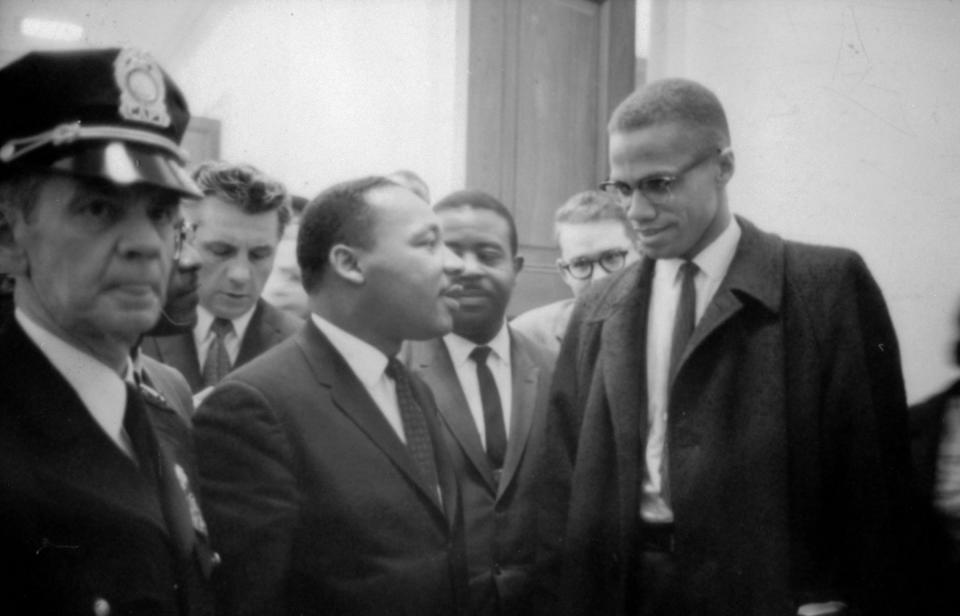The Story Behind the Photo of Martin Luther King Jr. and Malcolm X's Only Meeting

- Oops!Something went wrong.Please try again later.
- Oops!Something went wrong.Please try again later.
Martin Luther King Jr., played by Kelvin Harrison Jr., and Malcolm X, played by Aaron Pierre, are surrounded by reporters in the US Senate as seen in <i>Genius: MLK/X</i>. Credit - Richard DuCree—National Geographic
Martin Luther King Jr and Malcolm X are two of the most famous civil rights leaders in America. And yet, they only met once.
The photo seen below of the duo—King at left, Malcolm X at right—was taken 60 years ago this year on Mar. 26, 1964, at the U.S. Capitol. Segregationists in the U.S. Senate were filibustering the Civil Rights Act of 1964, and the two had come to support the passage of the legislation. The moment is recreated in the National Geographic biopic series Genius: MLK/X, out Feb. 1.
So why did it take so long for the activists to meet?
The exact answer is unclear, but there is at least one big reason why such a meeting would be risky.
More From TIME
“King understands he's under FBI surveillance, so, in a way, he had more to lose from such a meeting at the time,” says Peniel E. Joseph, a historian whose book The Sword and the Shield: The Revolutionary Lives of Malcolm X and Martin Luther King Jr inspired the Genius: MLK/X series.
The Genius: MLK/X scene gets that idea across, showing Malcolm X (Aaron Pierre) asking King (Kelvin Harrison Jr.), “Who do you think this is going to hurt more? You or me?” They then both laugh and smile at the cameras.
When the two activists met in real life, they exchanged pleasantries. Flanked by reporters and photographers, King bumped into Malcolm on his way out of the Capitol.
“Well, Malcolm, good to see you,” King said.
“Good to see you,” Malcolm X said.
According to the Washington Post, Malcolm X added, “I’m throwing myself into the heart of the civil rights struggle.”

Back then, Malcolm X was 38 and King was 35, and the two represented different perspectives in the Black community, with the Reverend King representing Black Christians, and Malcolm X representing Black Muslims. Malcolm X had just stopped doing activism work for Nation of Islam, a U.S. political and religious organization, after finding out that the leader of the group Elijah Muhammad had been having affairs with younger secretaries, getting them pregnant—a scandal depicted in the Genius: MLK/X series.
While both men were fighting for racial equality, they had different approaches. Joseph says Malcolm X was frustrated by how slow nonviolent protest was at bringing about change. As Malcolm X put it at a rally in Harlem two days before the encounter, “There will be nonviolence only with those who are not violent with us.” As Jonathan Eig’s biography King: A Life describes how the two amassed different followings, “King made it clear that people in power had better pay attention to him if they didn’t want to deal with his more antagonistic contemporary, while Malcolm moved audiences with the reminder that their anger was justified, that their self restraint need not be eternal, that not everyone had to maintain the kind of patience practiced by King.”
President Lyndon B. Johnson signed the Civil Rights Act into law on July 2, 1964, just a few months after the King and Malcolm X photo was taken. But the two would continue on parallel paths, and Malcolm X’s life was cut short before they had a chance to meet again. Almost a year after the photo was taken, Malcolm X was assassinated in New York City, on Feb. 21, 1965.
As the Washington Post reported, King sent a telegram to Malcolm X’s wife Betty (played by Jayme Lawson in Genius: MLK/X) saying, “While we did not always see eye to eye on methods to solve the race problem, I always had a deep affection for Malcolm and felt that he had a great ability to put his finger on the existence and root of the problem.”
Over the next few years, King would end up becoming disenchanted with Johnson, arguing that his Great Society programs weren’t going far enough to reduce poverty and speaking out against the Vietnam War. Like Malcolm, he was assassinated, fatally shot on April 4, 1968, in Memphis, Tenn.
Joseph sums up what the two legendary leaders had in common. “They're both thinking that we need that dignity and citizenship, not only for Black people, but also for all people. The biggest lesson is that both of them are revolutionaries, who start out as rivals and adversaries, but become dual sides of the same revolutionary coin over time.”
Genius: MLK/X can be streamed via National Geographic, Disney +, and Hulu.
Write to Olivia B. Waxman at olivia.waxman@time.com.

